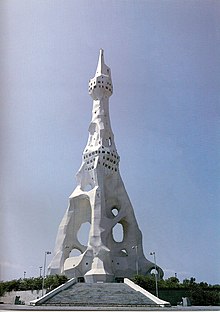New religions in Japan
Shinshūkyō ( Japanese 新 宗教 ) are New Religious Movements in Japan . They are also known in Japan as Shinkō shūkyō ( 新興 宗教 ), a word that is used less as a scientific term, but rather as "a word that expresses a certain social evaluation (and usually includes a feeling of contempt)" .
Japanese religious scholars classify all religious organizations founded in Japan since the mid-19th century as Shinshūkyō , even if they are organizationally assigned to one of the traditional schools of Buddhism. So the term encompasses a wide variety and number of organizations. Most of them originated in the middle of the 20th century and are influenced by older traditional religions, especially Shinto and Buddhism , but also Hinduism and Christianity . Some are syncretistic , others have fundamentalist traits, and many claim that they are not influenced by other religions.
Critics use the term Shinshūkyō in a negative sense ( sects ) and warn against joining them because they have concerns about their beliefs, their methods and goals and their proselytizing methods. An example often cited for this view is the Ōmu Shinrikyō , which became internationally known for its poison gas attack on the Tokyo subway in 1995.
In the case of the criticism often presented by representatives of the traditional, monastic- oriented Buddhist schools, however, one should take into account that it could also be motivated by the massive emigration of their lay followers. Current religious studies studies increasingly seek to avoid evaluations of the belief and practice of religious communities. While this approach is considered the norm in academic publications on established religions, it has not yet been consistently applied to new religious organizations.
Shinshūkyō before World War II
In the 1860s , Japan was marked by great social upheaval and rapid westernization. Social conflicts arose and with them some new religious movements, including Tenrikyō , Kurozumikyō and Ōmoto . Sometimes these three Nihon Sandai Shinkōshūkyō (lit. "Japan's three great Shinshūkyō") are called and are strongly influenced by Shinto and shamanism .
The Meiji - tennō raised the Shintō to a state cult (see State Shintō ). In the course of this political upheaval, the important new religions based on Shinto emerged (cf. also sectarian Shinto ). At the same time, the 250 year old ban on Christianity was lifted and Christian missionaries stimulated other religious movements.
Various Buddhist influenced lay movements appeared during this time. These took up various traditional schools of Japanese Buddhism and some also combined them with new ideas. The Japanese government found these movements suspicious and tried to suppress them. This suppression was particularly pronounced in the early 20th century, when state Shinto was closely integrated into Japanese nationalism and the reputation of Buddhism, which was viewed as foreign, superstitious and backward, reached a low point among the elites.
statistics
There is no reliable data on the number of members of the respective organizations. The reason for this is the general problem of collecting reliable figures, as many organizations do not offer permanent membership and / or do not make these figures openly available. Numbers are therefore often based on the organizations self-reported.
Some important Shinshūkyō
- Aleph, formerly Ōmu Shinrikyō
- Bussho Gonenkai Kyōdan
- Fuji Taisekiji Kenshōkai
- Izumo Ōyashirokyō
- Kofuku no Kagaku
- Konkōkyō
- Mahikari Kyodan
- Makuya
- Myōchikai Kyōdan
- Ōmoto
- PL [Perfect Liberty] Kyōdan
- Reiyūkai
- Risshō Kōseikai
- Seichō no Ie
- Sekai Kyūseikyō
- Shinnyo-en
- Sōka Gakkai
- Sūkyō Mahikari
- Tenrikyō
- Tenshō Kōtai Jingūkyō
See also
literature
- Peter B. Clarke (Ed.): Bibliography of Japanese New Religions with Annotations and an Introduction to Japanese New Religions at Home and Abroad. Plus an Appendix on Aum Shinrikyō . Japan Library, Richmond, 1999. ISBN 1-873410-80-8
- Clarke, Peter B., Somers, Jeffrey, editors (1994). Japanese New Religions in the West, Japan Library / Curzon Press, Kent, UK. ISBN 1-873410-24-7
- Clarke, Peter B. (2000). Japanese New Religions: In Global Perspective. Richmond: Curzon. ISBN 0-7007-1185-6
- Inoue Nobutaka / Johannes Laube (eds.): New religions: State of their research in Japan. A manual . Harrassowitz Verlag, Wiesbaden, 1995. ISBN 3-447-03508-0 .
- Lukas Pokorny: New Religious Movements in Japan Today: An Overview. In Hans Gerald Hödl, Veronica Futterknecht (Ed.) Religions after secularization. Festschrift for Johann Figl on his 65th birthday . LIT, Münster u. a., 2011, pp. 177-199. ISBN 978-3-643-50278-0
- Birgit Staemmler, Ulrich Dehn (Eds.): Establishing the Revolutionary: An Introduction to New Religions in Japan . LIT, Münster u. a., 2011. ISBN 978-3-643-90152-1
Individual evidence
- ^ Inoue Nobutaka / Johannes Laube (ed.): New religions: State of their research in Japan. A manual . Harrassowitz Verlag, Wiesbaden, 1995, p. 12. ISBN 3-447-03508-0
- ↑ James R. Lewis, Sect-Bashing in the Guise of Scholarship: A Critical Appraisal of Select Studies of Soka Gakkai, Marburg Journal of Religion: Volume 5, No. 1, p.1-2 (2000) digital version ( PDF; 137 kB)
Web links
- Inoue Nobutaka (1991): “ Recent Trends in the Study of Japanese New Religions ”
- Bernhard Scheid: " New Religions ", article in the web manual Religion-in-Japan
- Benjamin Dorman: “ New Religions through the Eyes of Ōya Sōichi, 'Emperor' of the Mass Media ”, in: Bulletin of the Nanzan Institute for Religion & Culture , 29/2005, pp. 54–67 (PDF file, 193.6 kB; English).
- Benjamin Dorman: “ SCAP's Scapegoat? The Authorities, New Religions, and a Postwar Taboo ”, in: Japanese Journal of Religious Studies 31/1: pp. 105–140 (PDF file, 296.1 kB; English).
- Robert Kisala: “ Images of God in Japanese New Religions ”, in: Bulletin of the Nanzan Institute for Religion & Culture , 25/2001, pp. 19–32 (PDF file, 147.3 kB; English).
